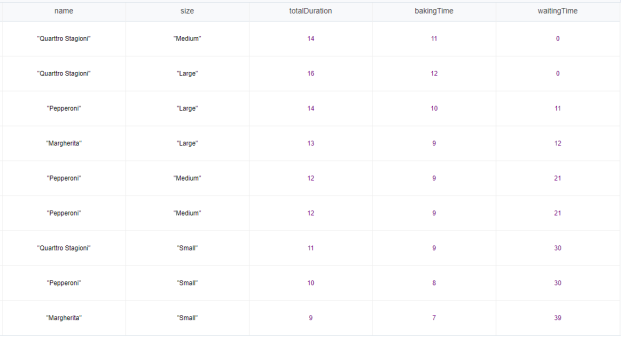In blog The various Decisions of a Decision Model we gave an overview of the various type of decisions that are available for a Decision Model. In this blog we show by means of an example that Decision Models can also be used for making complex decisions. We are going to make a decision model that determines the order of preparation of the pizzas in an order.
The order of preparation is determined by the baking time, the total preparation time of each pizza and the number of available ovens (1 pizza per oven). Let’s assume that we have an order for the following 9 pizzas:
- Small Margherita
- Large Margherita
- Small Pepperoni
- Medium Pepperoni
- Medium Pepperoni
- Large Pepperoni
- Small Quarttro Stagioni
- Medium Quarttro Stagioni
- Large Quarttro Stagioni
Expected outcome
The pizzas with the longest baking time are prepared first. When pizzas have the same baking time, the total preparation time is also taken into account to determine the order. As a result, to determine the sort order we first need to determine the baking time and total preparation time for each pizza.
Because not all pizzas can be prepared at the same time, pizzas that are not in the oven will have a waiting time. Once we have established the order, we can also determine the waiting time per pizza. We explain this with the help of the figure below.

This image shows the desired output of the decision model when using 2 oven. Result is sorted based on the longest baking time and total preparation time. As soon as a pizza is baked, the next one is picked up. So as soon as the first one is finished, the third pizza is put in the oven, and as soon as the second one is finished, the fourth one is put in the oven. And then when the third is ready we go on with the fifth. And so on. Based on the sorting, however, the second has a shorter time as the first one. The order of the first two pizzas is therefore reversed. For the same reason, the order of the first 3 must be reversed for 3 ovens and the order of the first 4 for 4 ovens.

It may be difficult to see, but the waiting time for the different pizzas is determined as follows:
– the first 2 can immediately go into the oven. They have no waiting time.
– third waits for the first
– fourth is waiting for the second
– fifth waits for the first and third
– sixth waits for second and fourth
– seventh is waiting for first, third and fifth
– eighth wait for second, fourth and sixth
– ninth finally wait for first, third, fifth and seventh
And for the completeness, when using 3 ovens we expect the following outcome:

And with 4 ovens:

For now we are determining the order of the pizzas within one of the orders, using this logic on multiple orders to determine what pizzas to prepare first is not supported yet.
Steps from Input to Output
Now lets see how to come from the input to the required output. We have the following steps to get from the input to the output:
- calculate baking time and total preparation time
- sort order by time
- apply sort order correction
- calculate waiting time
1 Calculate baking time and total preparation time
1.1 Pizza Level
We start by calculation the baking time. The baking time depends on the pizza type and size. For this we made a reusable function with a decisiontable in it.

For the duration another custom ‘getPreparationTime’’ function is used. This function determines how long it will take to prepare the pizza bottom or to add the filling.

Without getting into all the details, this function shows the usage of some default functions like ‘list’, ‘index of’, ‘number’ and ‘string’. This function returns 2 for a small pizza, 3 for a medium and 4 for a large pizza. When the size is none of these the functions return 0.
After getting the baking time the total duration can be determined. For this we have created a simple expression function.

1.2 Order Level
Now that we have defined the reusable functions to calculate the baking time and the total duration we need to apply these functions on the list of pizzas in the order.
Again we have defined a custom function. The function contains an expression with a for loop. For every pizza in the order, the following custom function (updatePizzaDetails) is called. In this call we also see that the previously defined functions for determining the times are used.

The ‘updatePizzaDetails’ function is a simple setter. A context with expressions.

Now we have also defined the function to perform the time calculations on the list. Calling this function is the last step for this part.
![]()
After calling this function we have the list that can be sorted.
2. Sort the order
For this, we will use the standard ‘sort’ operation. The sorting criteria that we use here are defined in a separate function.

The sorting criteria is in the Sorter.desc function.

Here we see, as mentioned earlier, that there is sorting on the baking time and on the total preparation time.
3. Sort order correction
At the expected output we have indicated that the order at the beginning of the list must be adjusted depending on the number of ovens. So first we have to define how many ovens there are. This can easily done by defining a ‘constant’ for the number of available ovens.

By changing this value, it is determined which of the above outputs the decision model gives. Next we defined a custom function with an if-then-else decision to correct the sort order.

Again we see the use of a number of standard functions. In this case all list related functions. In the ‘then’ part the first x-pizzas (depending on the number of ovens) are reversed. In the ‘else’ part the list remains unchanged. Normally, the list could simply be returned here, but this is currently not working properly. This results in a type casting error. As work-around the sublist function can be used, which also selects the entire list in our situation.
Finally we have to apply this function on the order/list.

4. Calculate waiting time
As the fourth and last step, the waiting time has yet to be calculated. Earlier in this blog we have already indicated how the waiting time is calculated. This we have incorporated into a decision table. This is shown below. The point of attention in this table is the used hit policy. This is C. Which means as much as “The output consists of a list of all matching rules”.



And ofcourse apply this function.

Expected outcome summarized
We have summarized these 4 steps in a context.

As outcome of the overall decision model we are only interested in the outcome of the fourth step.
To complete the order, the customer data is also added. The final output of the complete decision model then becomes:

This output is available in the PCS process that is using the Decision Model.






